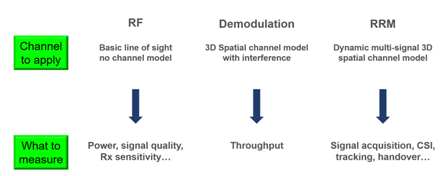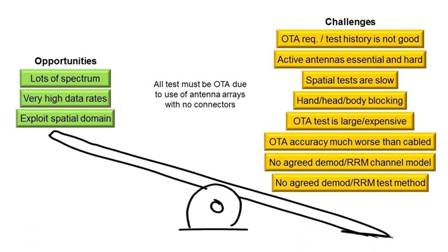By Moray, Lead Technologist, Keysight Technologies
 The emergence of 5G mobile communications is set to revolutionize everything we know about the design, testing, and operation of cellular systems. The industry goal to deploy 5G in the 2020 timeframe demands mmWave over-the-air (OTA) requirements and test solutions in little more than half the time taken to develop the basic 4G MIMO OTA test methods we have today.
The emergence of 5G mobile communications is set to revolutionize everything we know about the design, testing, and operation of cellular systems. The industry goal to deploy 5G in the 2020 timeframe demands mmWave over-the-air (OTA) requirements and test solutions in little more than half the time taken to develop the basic 4G MIMO OTA test methods we have today.
If you remember anything from this blog post, know this:
“At mmWave frequencies, we are going to have to do all of our testing radiated, and not just some of it like we do today for LTE, and that’s a BIG deal.”
First, a bit of background on the move from cabled to radiated testing, and then I’ll discuss the three main areas of testing that we’re going to have to deal with: RF test, demodulation test, and radio resource management (RRM).
Millimeter-wave devices with massive antenna arrays cannot be tested using cables because there will be no possibility to add connectors for every antenna element. The dynamic (active) nature of antenna arrays means it isn’t possible to extrapolate end-to-end performance from measurements of individual antenna elements. So yes, for testing 5G, it really is time to throw away the cables…whether we want to or not!
Correctly Modelling the mmWave Channel is the Key to Designing a 5G System That Actually Works
 A new radio design starts with the reality of the deployment environment, in this case a mmWave one. How this behaves isn’t a committee decision, rather it’s the laws of physics that are not up for debate! Next, we model the radio channel, and once we have a model, we can design a new radio specification to fit the model. Then, we design products to meet the new radio specifications, and finally we test those products against our starting assumptions in the model. If we have got it right—in other words, if the model is sufficiently overlapped with reality—then products that pass the tests should work when they are deployed in the real environment. That’s the theory. While we know how to run this process at low frequencies, for mmWave, there is a big step up as the difference in the propagation conditions is enormous and our understanding for that is still growing.
A new radio design starts with the reality of the deployment environment, in this case a mmWave one. How this behaves isn’t a committee decision, rather it’s the laws of physics that are not up for debate! Next, we model the radio channel, and once we have a model, we can design a new radio specification to fit the model. Then, we design products to meet the new radio specifications, and finally we test those products against our starting assumptions in the model. If we have got it right—in other words, if the model is sufficiently overlapped with reality—then products that pass the tests should work when they are deployed in the real environment. That’s the theory. While we know how to run this process at low frequencies, for mmWave, there is a big step up as the difference in the propagation conditions is enormous and our understanding for that is still growing.
Now let’s look at the scope of radio requirements that we’re going to have to validate—that is, what we have to measure, and critically, the environment or channel in which we measure them.
The Scope of 5G mmWave OTA Testing
 For RF, it’s about what is already familiar—power signal quality, sensitivity—and those are all measured in an ideal line-of-sight channel. With regards to demodulation, throughput tests will be done in non-ideal (faded) conditions as was the case for LTE MIMO OTA. There we had 2D spatial channels, but for mmWave, the requirement will be 3D spatial channels because the 2D assumptions at low frequencies are no longer accurate enough. In addition, we need to include spatial interference, since the omnidirectional interference assumed for LTE is no longer realistic at mmWave due to narrow bandwidths. Radio resource management (RRM) requirements are about signal acquisition and channel-state information (CSI) reporting, signal tracking, handover, etc. That environment is even more complicated because now we’ll have a dynamic multi-signal 3D environment unlike the static geometry we have for the majority of demodulation tests.
For RF, it’s about what is already familiar—power signal quality, sensitivity—and those are all measured in an ideal line-of-sight channel. With regards to demodulation, throughput tests will be done in non-ideal (faded) conditions as was the case for LTE MIMO OTA. There we had 2D spatial channels, but for mmWave, the requirement will be 3D spatial channels because the 2D assumptions at low frequencies are no longer accurate enough. In addition, we need to include spatial interference, since the omnidirectional interference assumed for LTE is no longer realistic at mmWave due to narrow bandwidths. Radio resource management (RRM) requirements are about signal acquisition and channel-state information (CSI) reporting, signal tracking, handover, etc. That environment is even more complicated because now we’ll have a dynamic multi-signal 3D environment unlike the static geometry we have for the majority of demodulation tests.
Balancing Out 5G mmWave Opportunities and Challenges
 The benefits of 5G and mmWave have been well publicized. There’s a lot of spectrum that will allow higher network capacity and data rates, and we can exploit the spatial domain and get better efficiencies. However, testing all of this has to be done over the air and that presents a number of challenges that we have to solve if we’re going to have satisfied 5G customers.
The benefits of 5G and mmWave have been well publicized. There’s a lot of spectrum that will allow higher network capacity and data rates, and we can exploit the spatial domain and get better efficiencies. However, testing all of this has to be done over the air and that presents a number of challenges that we have to solve if we’re going to have satisfied 5G customers.
- We know that we’re going to have to use active antennas with narrow beams in user devices and base stations, and those are much harder to deal with than fixed antennas with wide beams.
- We know that spatial tests are slower than cabled, so you can expect long test times.
- We’ve got the whole issue of head, hand, body blocking on user devices—it’s something that isn’t being considered a priority for release-15 within 3GPP but will nevertheless impact customer experience.
- We know that OTA testing requires large chambers and is expensive.
- We know OTA accuracy is not as good as cabled testing—we’re going to have to get used to that, particularly at mmWave frequencies where provisional uncertainties are above 6 dB.
- Channel models for demodulation and RRM tests haven’t been agreed upon yet, which is impacting agreement on baseline test methods for demodulation and RRM.
Takeaways
With 5G mobile communications, there’s a paradigm shift going on because of mmWave. We used to work below 6 GHz and the question we asked was, “How good is my signal?” That question led to the development of non-spatial conducted requirements. The question now for mmWave is, “Where is my signal?” That’s going to lead to the development of 3D spatial requirements which can only be validated using OTA testing. This is a fundamental shift in the industry that will impact the entire design and test flow.
It’s going to be a tall order testing 5G mmWave devices. In spite of the unknowns, Keysight is committed to getting our customers on the fastest path to 5G. Stay tuned as Keysight continues to roll out 5G testing methodologies and system solutions. Explore the 5G resources currently available.
This article is an adaptation of Moray’s original post published in the Next Generation Wireless Communications Blog, where you can connect with our industry and solution experts as they share their experiences, opinions and measurement tips on a number of cellular and wireless design and test topics that matter to you.







